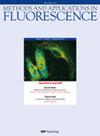用于高微粘度环境的红色荧光BODIPY分子转子
IF 2.4
3区 化学
Q3 CHEMISTRY, ANALYTICAL
引用次数: 0
摘要
微粘度对生物环境中的扩散控制过程具有重要影响。BODIPY分子转子是粘度敏感的荧光团,提供了一种简单而非侵入性的方法来观察微粘度。虽然绿色荧光探针已经很好地用于成像,但厚的生物样品需要更长的波长进行研究。这项工作的重点是研究具有红色发射的新型β-取代中苯基bodipys。我们报道了一种新的基于bodipy的红色荧光探针BP-Vinyl-NO2,适用于在超过100,000 cP粘度的刚性环境中检测微粘度。此外,我们证明了将β-苯基取代的共轭物BP-PH-m2M-NO2的甲基位置从邻位改变为间位,可以在保持粘度敏感性的同时使吸光度和荧光光谱发生红移。最后,我们表明硝基取代中苯基是一种通用的方法,可以提高对粘度的敏感性,同时抑制对此类衍生物的极性和温度的敏感性。总之,我们提出了两种硝基取代的红色荧光探针,可以用作基于寿命的微粘度传感器。本文章由计算机程序翻译,如有差异,请以英文原文为准。
Red fluorescent BODIPY molecular rotor for high microviscosity environments
Microviscosity has a strong impact for diffusion-controlled processes in biological environments. BODIPY molecular rotors are viscosity-sensitive fluorophores that provide a simple and non-invasive way to visualise microviscosity. Although green fluorescent probes are already well developed for imaging, thick biological samples require longer wavelengths for investigation. This work focuses on the examination of novel β-substituted meso-phenyl-BODIPYs possessing a red emission. We report a new red fluorescent BODIPY-based probe BP-Vinyl-NO2 suitable for sensing microviscosity in rigid environments of over 100 000 cP viscosities. Furthermore, we demonstrate that changing the methyl position from ortho to meta on the β-phenyl-substituted conjugate BP-PH-m2M-NO2 redshifts absorbance and fluorescence spectra while maintaining viscosity sensitivity. Finally, we show that nitro-substitution of meso-phenyl is a versatile approach to improve the sensitivity to viscosity while suppressing sensitivity to polarity and temperature of such derivatives. In summary, we present two nitro-substituted red fluorescent probes that could be used as lifetime-based microviscosity sensors.
求助全文
通过发布文献求助,成功后即可免费获取论文全文。
去求助
来源期刊

Methods and Applications in Fluorescence
CHEMISTRY, ANALYTICALCHEMISTRY, PHYSICAL&n-CHEMISTRY, PHYSICAL
CiteScore
6.20
自引率
3.10%
发文量
60
期刊介绍:
Methods and Applications in Fluorescence focuses on new developments in fluorescence spectroscopy, imaging, microscopy, fluorescent probes, labels and (nano)materials. It will feature both methods and advanced (bio)applications and accepts original research articles, reviews and technical notes.
 求助内容:
求助内容: 应助结果提醒方式:
应助结果提醒方式:


